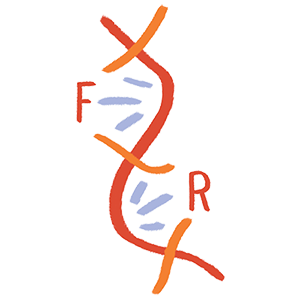
A line of people (and one cat) hold hands on a grassy field between a forest and a stream. In the foreground, hands striving to create a more socially just, equitable, and accountable science pull apart the chains of a fence linked together by harmful systems. Illustration by Sophie Wang @wangshuf
One question that we have asked and frequently been asked is the following: “What are the ways that people actually use science and social justice together in practice?” Well, to begin to answer that question, we’ve put together a short list of the practical intersection of science and social justice, covering topics from DIY reproductive health to how to use technology to combat state violence. Hope you enjoy!
– Free Rads Team
1) Making Statistics Work for Marginalized Communities
The government and community-based organizations often rely on Census data and other demographic information to determine how to allocate resources and funding. The Asian American and Pacific Islander (AAPI) grouping has been a point of contention given the broad disparities in health, education, immigration status, and other factors within the AAPI label. Many AAPI community and policy organizations, alongside national and state governing bodies, are currently pushing for greater data disaggregation to ensure that the unique communities within the AAPI name are accurately represented and statistically independent.
2) DIY Pollutant Monitoring – Science From Community, For Community
Students in Todd Honma’s Science, Technology, and Asian American class at Pitzer College worked with students at Mark Keppel High School in Alhambra, CA to develop air pollution sensors. Mark Keppel, like many high schools with a majority population of students of color, is located adjacent to a freeway, and students at the school expressed concern that high pollutant levels from the freeway may be affecting student health. The students in the Pitzer class leveraged their technical skills and access to 3-D printing technology to build the sensors, which are currently still in development. This collaboration illustrates just one of the ways technological expertise can be combined with a social justice framework and community-voiced needs to effect change.
In a similar vein, residents of Norco, Louisiana, a predominantly low-income Black community, collected air quality data through “bucket monitoring”, a low-cost sampling method to measure toxic chemicals produced by the nearby Shell Chemical Plant. Residents found that industrial incidents such as fires or spills caused peak toxic emissions that exceeded regulatory standards and threatened human health. Environmental justice activists were then able to use this data to lobby the EPA, resulting in a multi-year, industry-sponsored, agency-supervised study of Norco’s air quality. Ultimately, Norco residents successfully pressured Shell into offering relocation packages.
3) Developing Community Driven Mental Health Care
People with different cultural backgrounds face different issues concerning their mental health, and respond to treatment in different ways. This can create disparities in the effectiveness of conventional forms of treatment for people from different cultural backgrounds including those who identify as Asian American and Pacific Islander (AAPI). Psychologist Dr. Wei-Chin Hwang conducts research to better understand where these disparities lie, and how to combat them using culturally competent interventions developed within of the communities they aim to serve.
4) Local Doctors and Lead Poisoning
Last year, the lead-poisoning water crisis in Flint, Michigan called attention to the marginalization of people of color communities. State officials had refused to legitimize concerns over water quality, but pediatrician Mona Hanna-Attisha (@MonaHannaA), dug deep into hospital files to find that children of Flint had elevated blood-lead levels. She continues advocacy with Flint community members to demand that state officials take responsibility for their negligence and provide aid to rebuild crucial water systems. Her work along with that of other scientists helped turn a national spotlight on the need for critical infrastructure support and better community accountability on behalf of state officials.
5) Mobile Technology to Combat State Violence
The ACLU’s Mobile Justice slate of phone applications is an example of appropriating technology to combat state violence, by allowing smartphone owners to record and report instances of police brutality or other interactions with law enforcement. Video recorded with the app is automatically and immediately sent to the ACLU. This mechanism prevents situations in which the recording phone is confiscated and the recording is deleted before it can be seen by anyone else.
6) DIY Science Hacks Reproductive Health (with Punk Speculums)
The collective GynePunks, a feminist bio-hacking group, is using cheap 3D printers and repurposed technology to make a DIY gynaecological testing kit, which includes tools like homemade speculum. Citing the racist and sexist historical origins of the field of gynecology, the trauma many experience in OB/GYN offices, and the lack of access to reproductive health information and services, GynePunk members were inspired to help people take control of their own reproductive health. Although cost, time, and expertise are barriers to sharing their work more widely, GynePunks represents some of the best that the DIYbio and Makerspace movements have to offer toward making science work for social justice.

